Fancy a Meat Pie?
What I have hea is a rawther nice British meat pie (This is OBVIOUSLY accent, not typos… don’t be an arse about tit). Eva since I overcame my fear in baking (sort of…), I admit that I’ve gone a bit bonkers! What to pie next? What to pie next? Out of all the brilliant recipes out thea, this one has somehow stick. For one it looks bloody delicious, absolutely pukka! And second I believe it’s pure fate. First I saw it on the tele when they were talking about British street foods, and then a magazine featuring the exact same thing LIT’erally fell on my lap. Two makes it a sign.
…Is it as difficault to read as it tis to write in a Brit accent….? I have new found respect for Lindsay Lohan. Oooh sod it! I give up…
Plllirrrr… plirrrah… pliirrah…. plirrr… I’m relaxing my tongue OK (I hope there’s a howtospellnoises.com).
So, one may say that this looks awfully lot like Pâté en Croûte, a rectangular meat pate in pastry shell. Well, that is absolutely correct. In fact I believe this may be a little “posh” British cousin of the French classic because they share too many unmistakably similar characteristics. Both are ground meat wrapped and baked in a butter (or suet) crust. Both are filled with some sort of stock gello and for that reason, both are eaten cold. Plus their suspiciously close geographic origins, I here pronounce them definitely related. But the British version scores a point in portability and let’s face it, smaller makes it more adorable! Yeah, even foods look more chic after being downsized…
For Rachel Ray fans, this could look a tad bit intimidating. Well, yes and no. I sort of had an afterthought epiphany that it’s one of the few things that I can cheat my way through and still end up with something that looks exactly the same. The one element that really takes most of the time is the pork trotter stock, which produces the stock gello and shredded pork for the filling. But THEORETICALLY it’s easily “fakable” with just regular chicken stock plus… DUH! store-bought gelatine!! And the meat filling can really just be any ground meat mixture. It WON’T taste the same, but it would certainly look identical. Well, like I said this is an “afterthought”. So next time when I test my own theory and fail miserably I will let Bloggy know.
For now, let’s do it the hard way.
Servings: 5 ~ 6 pies
Pork Trotter Stock:
- 2 pork trotters cut into 4 pieces (ask the butcher to do this)
- 1 pork ham bone
- 1 pork sham/ham hock or 5 pieces of backbone with meat (essentially any “meat on the bone” parts are fine)
- 7 sprigs of thyme
- 1 onion
- 2 celery stalk
- 2 slices of ginger
- 3 cloves of garlic
- 1 tsp of black peppercorns
Meat filling:
- 500 g of ground pork
- Skin and meat from 1 pork trotter from the stock
- All the meat from the sham/ham hock, or the backbones from the stock
- 1/2 finely diced onion
- 1 grated garlic
- 1 tsp of black and white pepper
- 3 tbsp of corn starch
- 7 sprigs of thyme
- Salt
Pie Crust:
- 500 g of flour
- 200 g of butter
- 1 tbsp of salt
- 270 ~ 300 ml of boiling water
Egg Wash:
- Whisk 1 egg + 1 tsp of water together
I think the timeline format for the Creme Brulee Pie worked out pretty nicely, so from now on I will do all the “Got Nothing But Time” category in timeline. Don’t worry. The instruction this time isn’t as hideously long as the Creme brulee pie because the dough does not require chilling, nor is it pre-baked. However, pre-baking WILL IMPROVE the texture of the crust so overachievers, knock yourselves out.
1:00 ~ 1:20 pm – Place the trotters, ham bone and backbones in a big stock pot with 3 pieces of ginger (this will remove any unpleasant odor from the pork and give the stock a “clean” taste). Fill it up with cold water and bring to a boil. Let it simmer for 2 minutes, then drain the water and rinse all the pork pieces under cold water until very clean.
1:20 ~ 2:30 pm – Place all the pork pieces into a pressure cooker. Add 1 halved onion, thyme, garlic, ginger, celery and peppercorns. Fill the water till it just covers the pork pieces. Put the lid on and lock it. Bring the pressure cooker to the “hissing” point on high heat. Then turn the heat down to medium low, and let it “hiss” for 1 hour and turn off the heat.
2:40 ~ 3:00 pm – Wait until all the pressure’s released and drain all pieces out through a sieve. Return 1 trotter into the stock in another pot, and simmer/reduce the stock by 2/3 then spoon out the fat on the top.
3:00 ~3:30 pm – While the stock is being reduces, remove the skin and meat from the 1 trotter and all the backbones or ham hocks. Shred all the skin and meat in pieces, then add the ground pork, diced onion, grated garlic, corn starch and thyme. Mix them up really well and season with salt. That’s the filing.
3:30 ~ 4:00 pm – Now make the dough. In a mixer, combine flour, chilled and diced butter, salt on low speed. Slowly add in the boiling water. The recipe calls for 300ml of boiling water, but for some reason, it only took me about 270ml to form a dough. So any amount in between 270 to 300 ml depending. Knead the dough in the mixer on low until smooth, about 2 ~ 3 min.
4:00 ~ 4:40 pm – Preheat the oven on 360ºF/180ºC. Now, the boiling water has pretty much killed all the gluten in the flour so the dough doesn’t really need much “resting”. Prepare 5 cylinder-shape molds or cups.
Take 1 piece of dough the size of a tennis ball. Flour the working surface and rolling pin, and roll the dough out into a 1/4″, 0.5 cm circle. Drape the dough over the mold and lightly press it in to fit and let excess dough drape over the mold. IMPORTANT!! Please please please make sure that there isn’t any holes or “thinning” patches that may potentially be a leaking hazard.
Fill the cavity with the meat filing. Take another smaller piece of dough and roll it out to the same thickness. Cut a big circle out (big enough to cap the mold), then cut a smaller circle in the center. Place the “lid” dough on the mold and TIGHTLY TIGHTLY seal the edges with a bit of egg wash, then trim off the excess dough (the trimmings can be reused for the next mold). Use a fork to pinch the edges together. IMPORTANT!! Please please please make sure that there isn’t any hole or crack between the attachment that may potentially be another leaking hazard. This crust will later act as a container that holds the stock gello, which is of course initially in liquid form. Filling in the stock from the top while it leaks and oozes out from the side is as close as it gets to a disaster in the kitchen… I mean… I would imagine of course…
So repeat the steps for all 5 molds.
4:40 ~ 5:25 pm – Brush the top with egg wash and bake in the oven for 45 min.
5:25 ~ 5:50 pm – Carefully remove each pies from the mold. If it’s sticking slightly to the mold, use a thin knife to score the edges WITHOUT puncturing the crust. Brush the sides of each pies with egg wash.
5:50 ~ 6:20 pm – Return the pies into the oven and bake until all sides are golden browned. About 20 ~ 30 min.
6:20 ~ 6:40 pm – Transfer the pies onto a cooling rack. Warm the reduced stock. It doesn’t have to boil. The whole point is to bring it to liquid form so it can be poured into the pie. Even though the trotters have provided enough gelatin for the stock, I still added a little bit of packaged gelatin to help it out a little bit. Pour the stock into the small hole on top of the pie SLOWLY. Fill it to the top, and then the stock will seep into the pie, then fill again. Until the stock doesn’t go down anymore. IF UNFORTUNATELY, the stock is leaking somehow… DON’T PANIC. Use the leftover dough to clog any leakage then remove it once the pies have cooled down completely.
6:40 ~ 8:00 pm – Let the pies cool down COMPLETELY for at least 2 hours. The stock needs to solidify otherwise it will ooze out when the pie’s cut open.
8:00 pm – Just in time for dinner. Dijon mustard is a MUST companion for the pies. These pies are also perfect to be made the day before a brunch party.
[subscribe2]

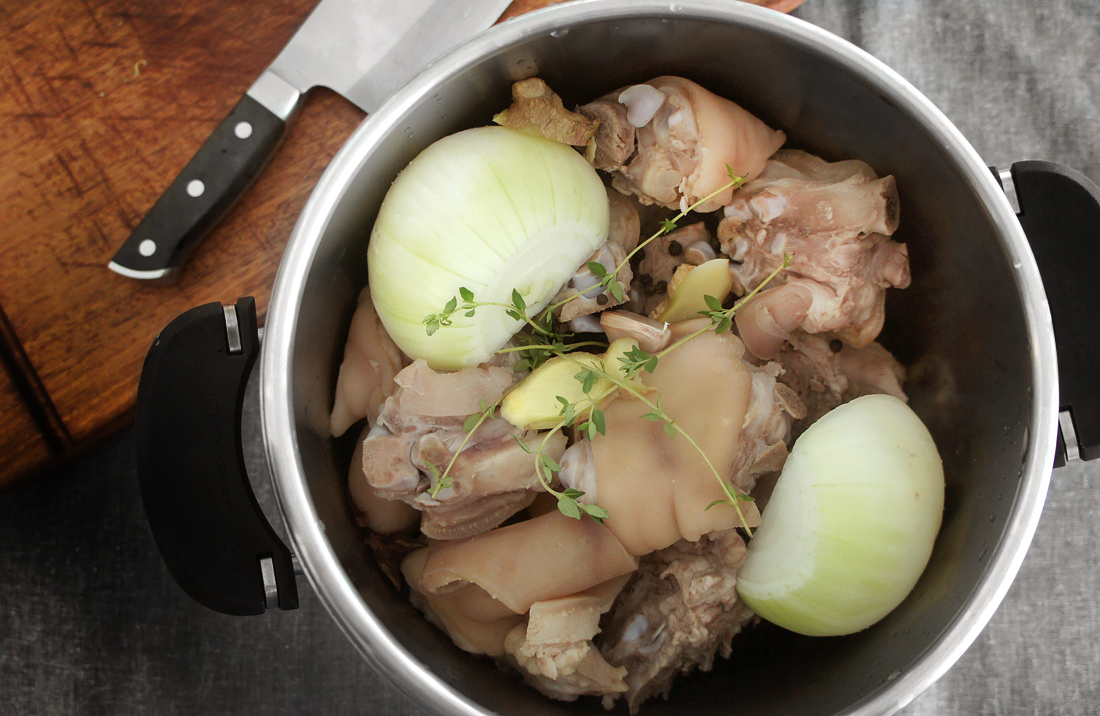
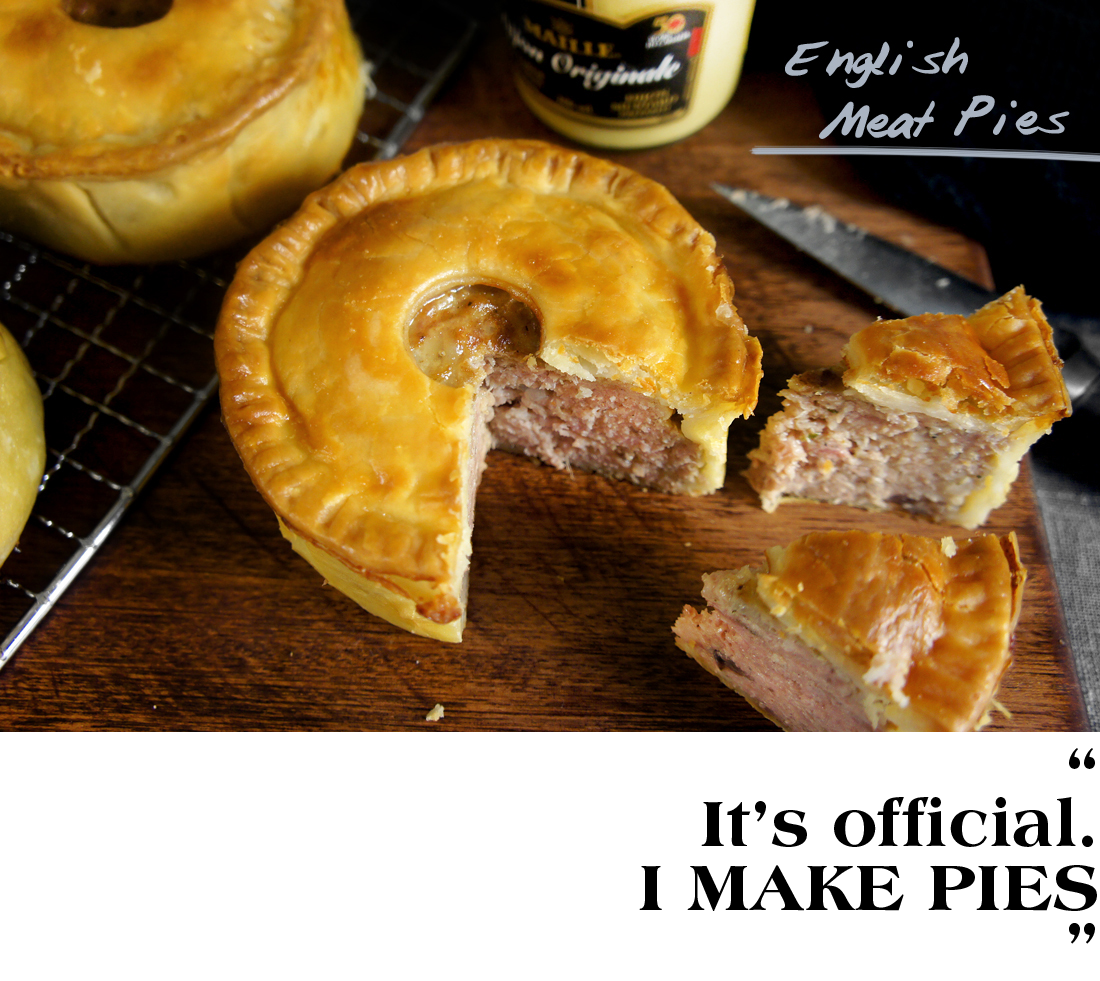

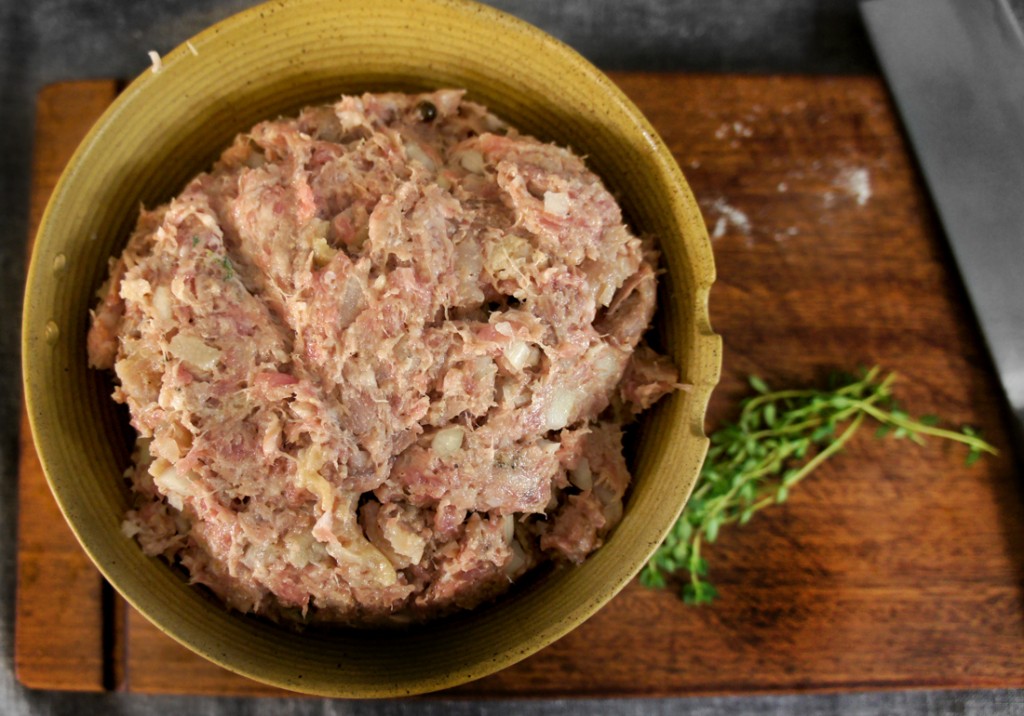
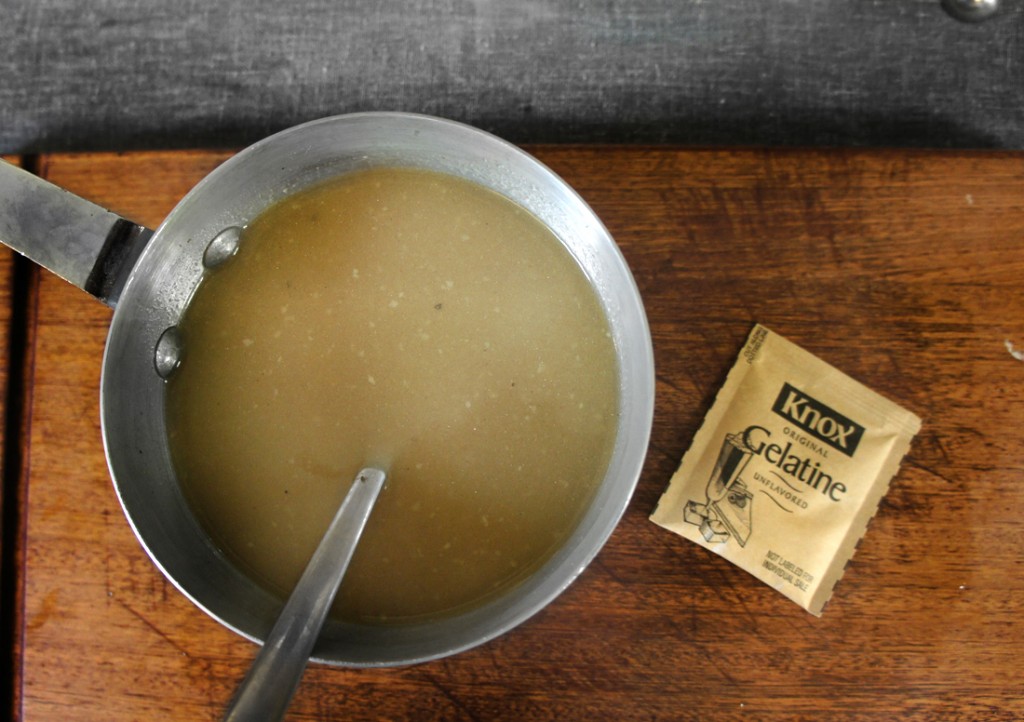
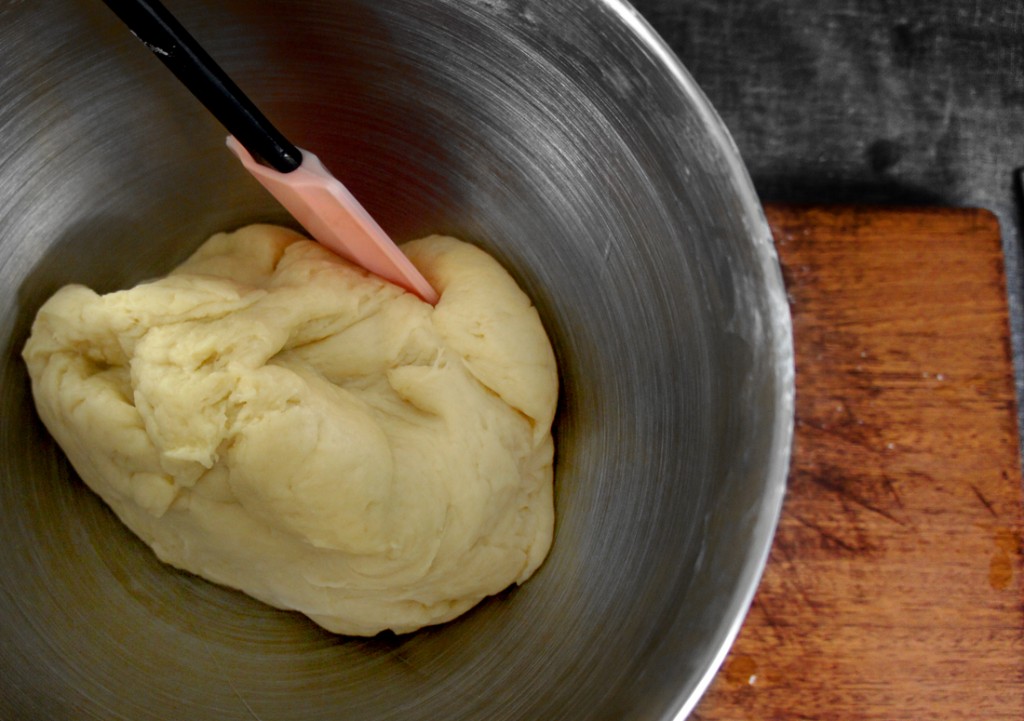
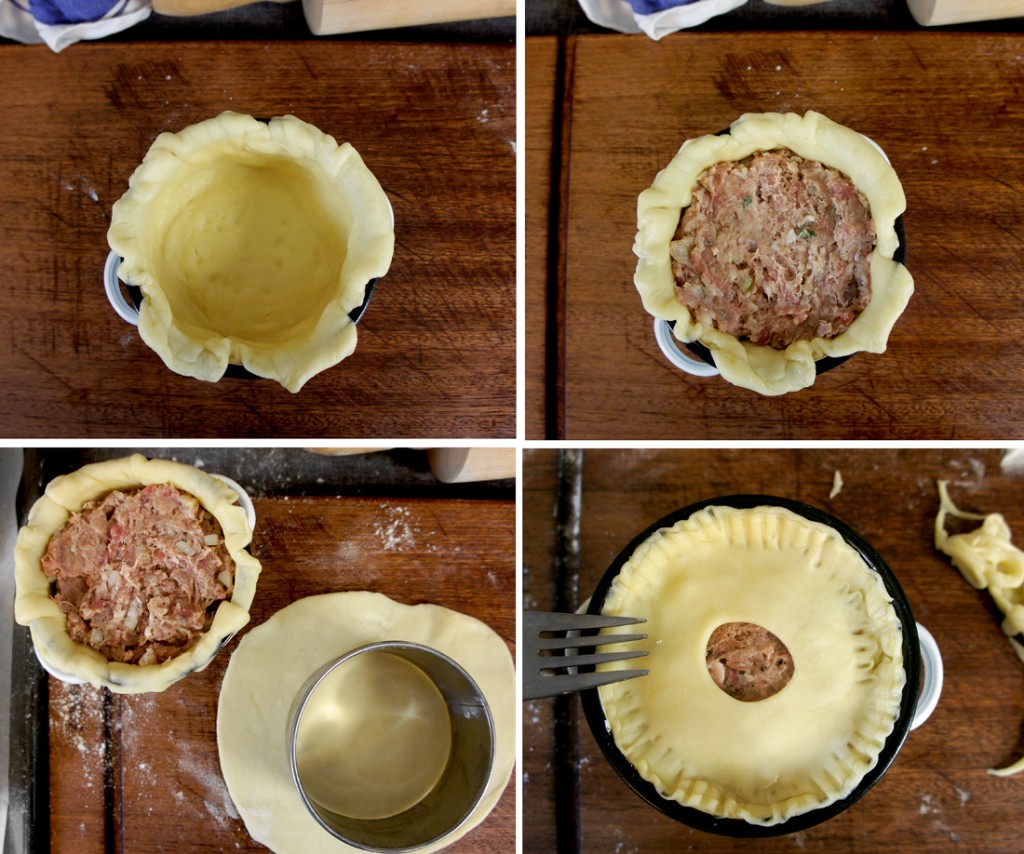
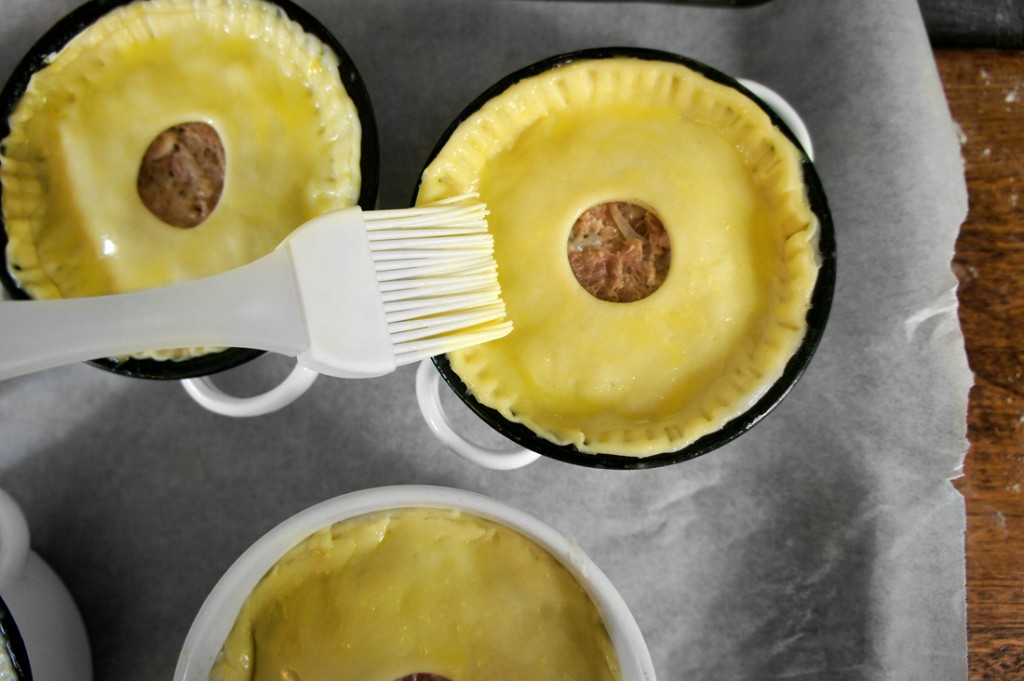
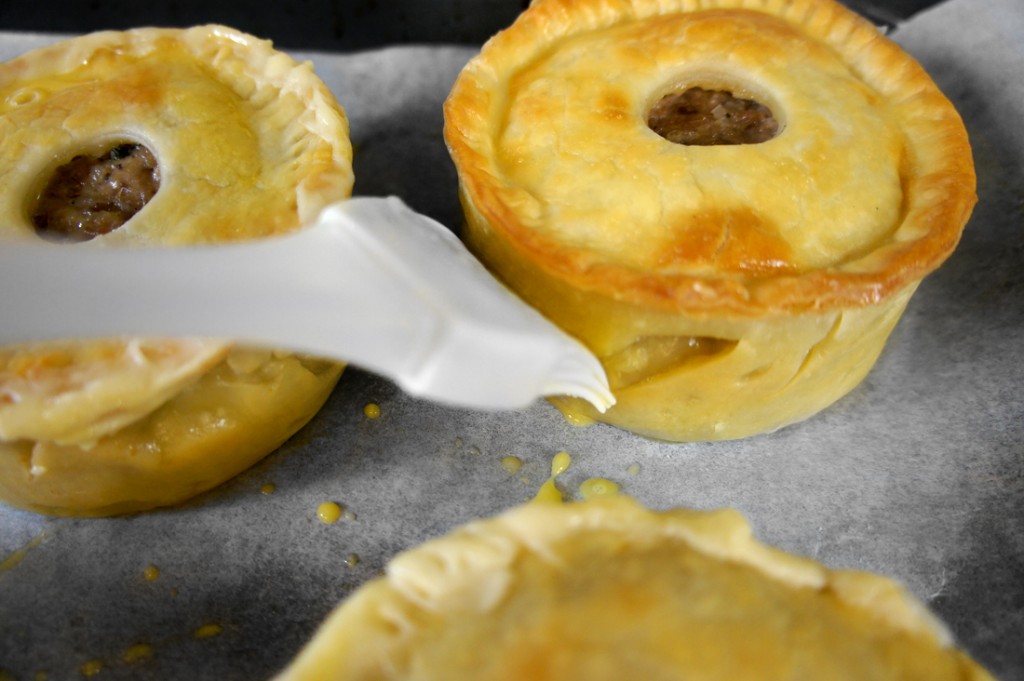
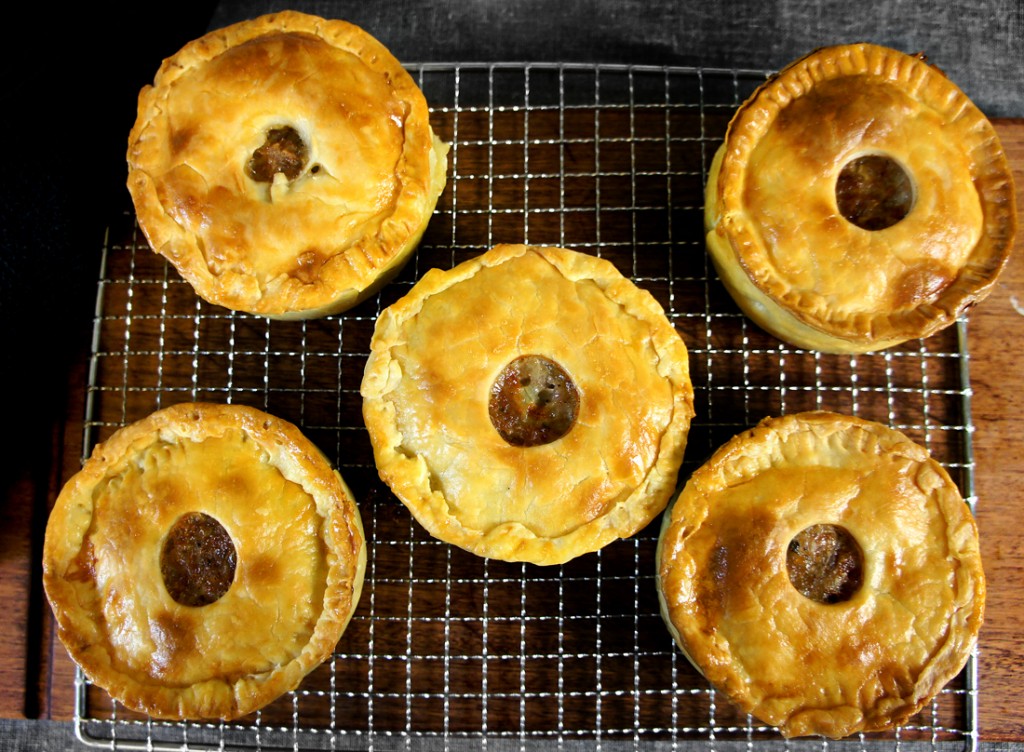
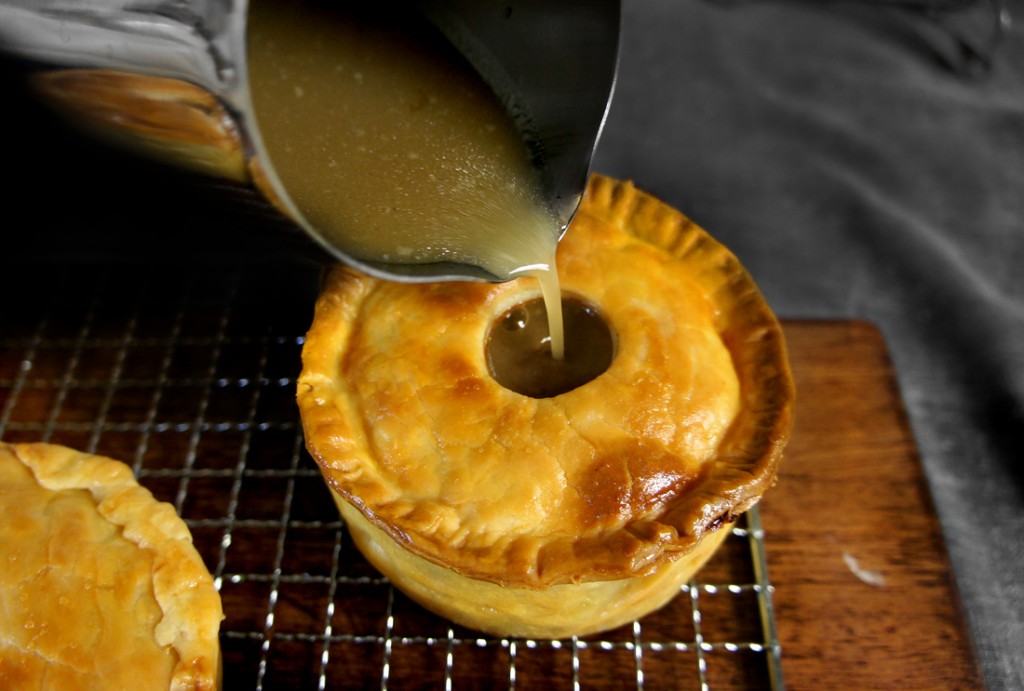
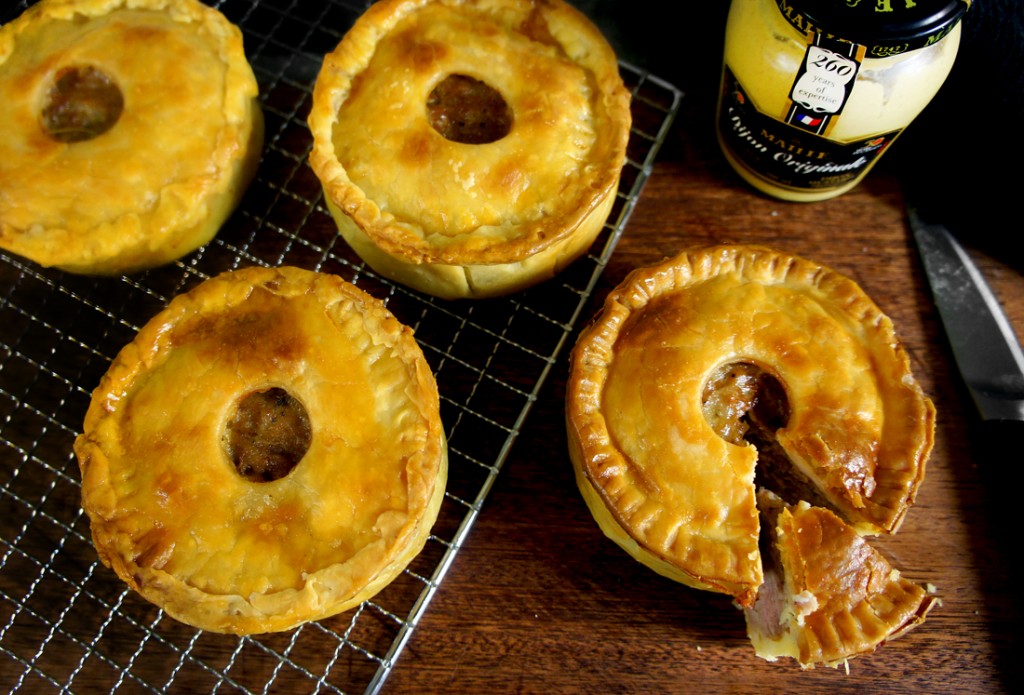
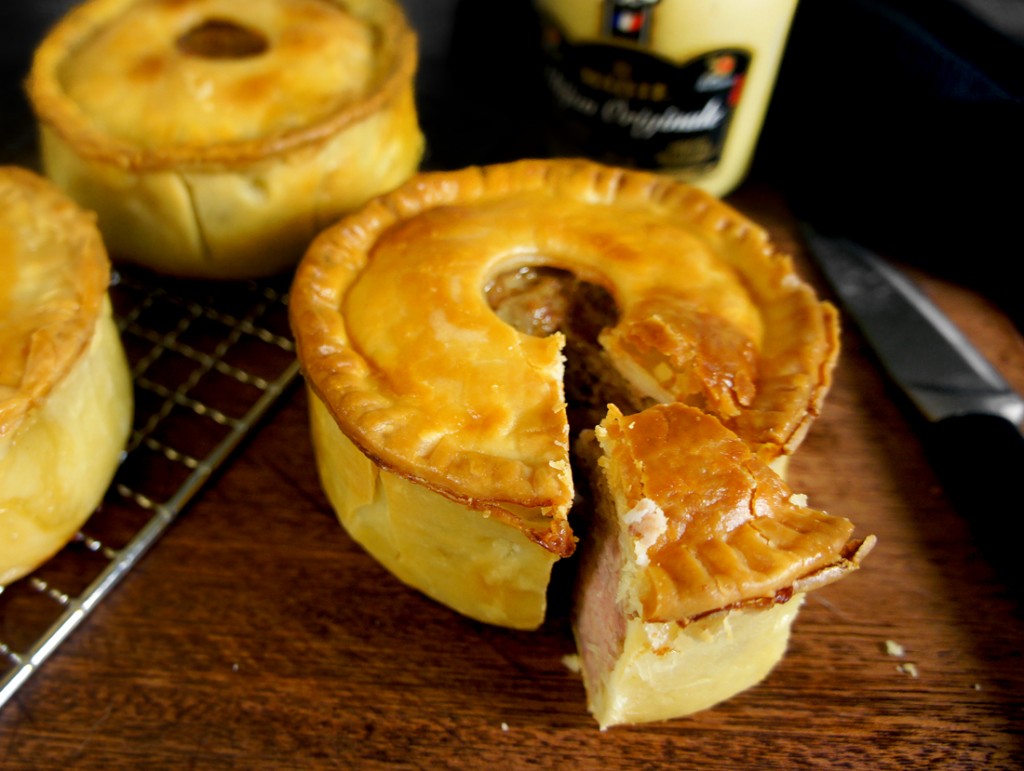
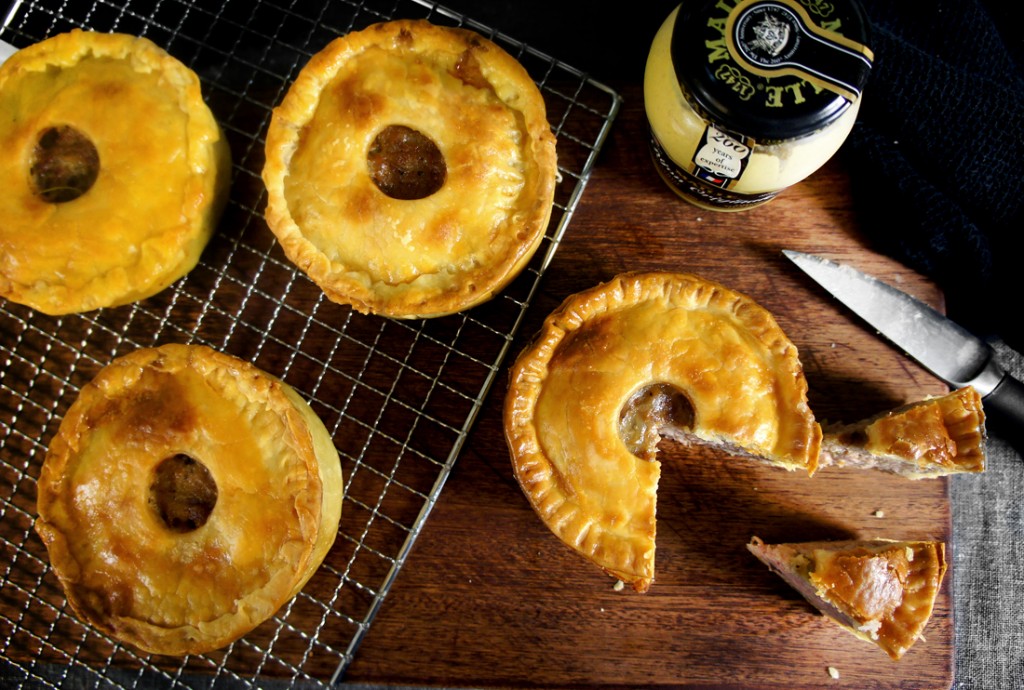
Melinda
03.29.2013at2:22 AMWhat are the approximate dimensions of the molds?
Mandy L.
03.29.2013at2:28 PMHi Melinda, the mold I used is around 4″/10cm in diameter. But you could use a narrower/taller mold or even a large pie mold. I have seen both being used.
Aly
07.22.2016at11:08 PMI have found that small springform pans also work well as molds. I have a small one for making savoury cheesecakes. The rings are easy to open up and remove
Sarah
07.25.2018at5:21 AMThanks for very helpful directions and photos. Someone gave me some leftover cooked beef and i used your crust recipe to make a meat pie. I needed to use even less water than you did for the crust. I also used buttered ceramic soufflé dishes as the mold. All has turned out well.